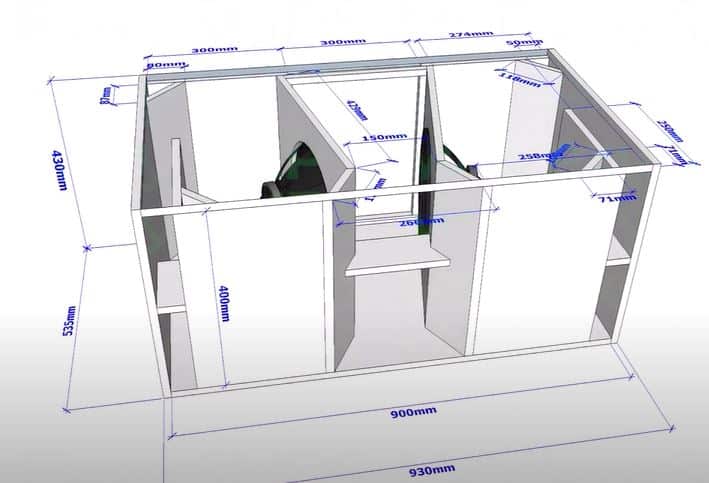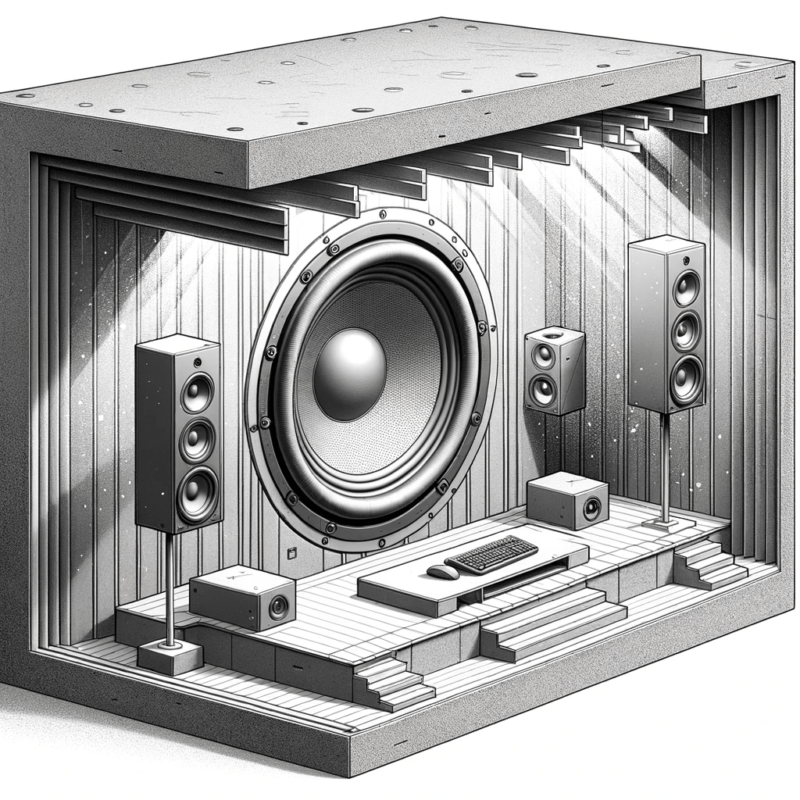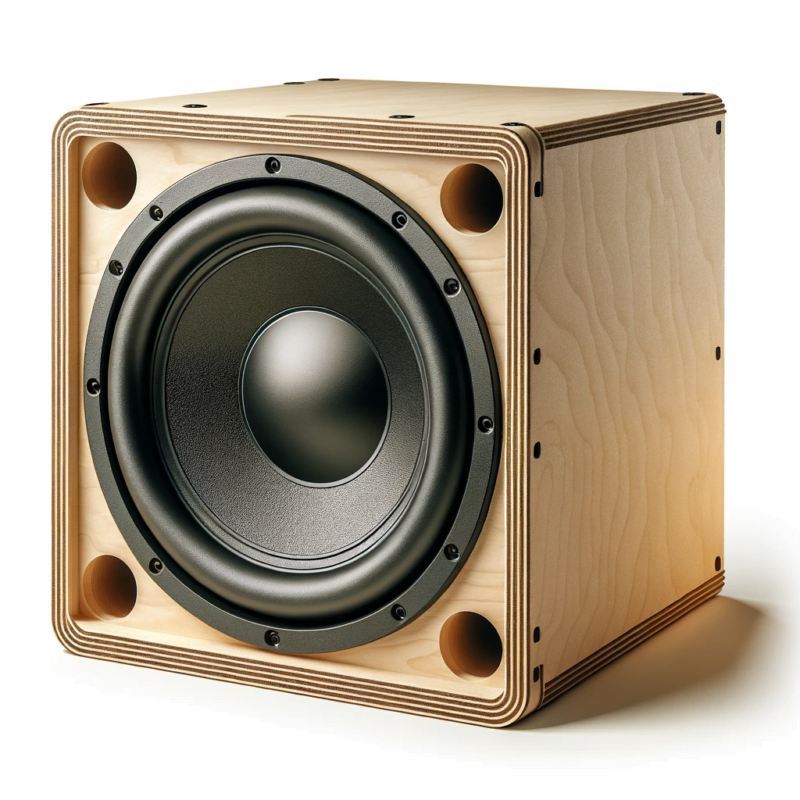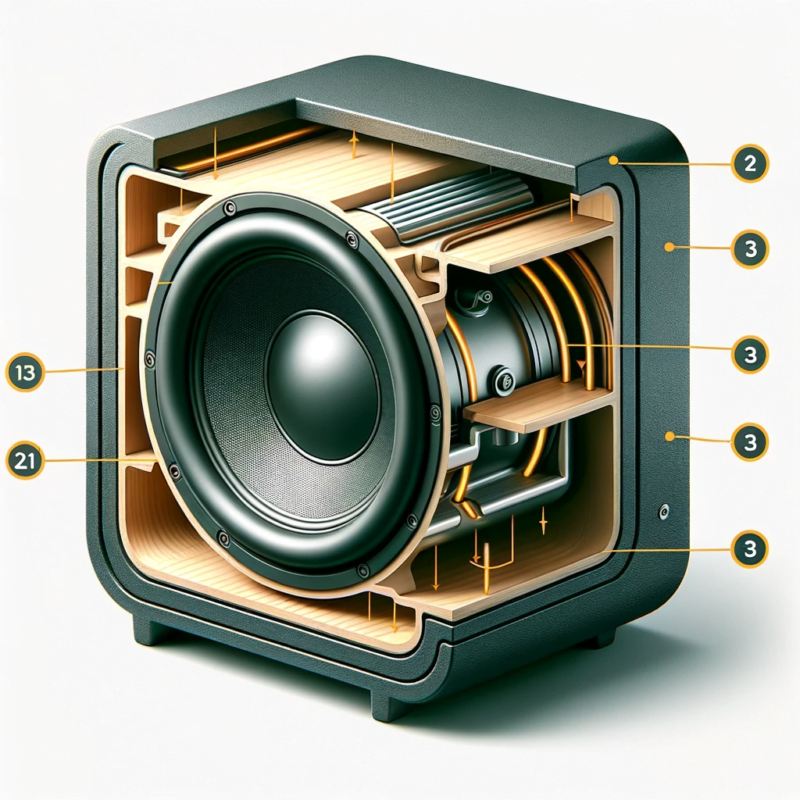Bandpass Subwoofer Box – Unlock the Mystery

Subwoofers are an essential component of any audio system, delivering deep, low-frequency bass that adds power and impact to the overall sound quality. To optimize the performance of subwoofers, it is crucial to choose the best way to design the proper enclosure. One option that stands out is the bandpass bo,x, which offers several advantages over other enclosure types. In this blog, we will explore the benefits of bandpass enclosures for subwoofers, their functionality, construction design, and the types available in the market. Whether you are a home audio enthusiast or a professional audio system installer, understanding the advantages of bandpass subwoofer box can help you enhance your subwoofer experience.
Understanding a Bandpass Subwoofer Box
Bandpass subwoofer enclosures have gained popularity among audio enthusiasts due to their unique design and performance capabilities. These enclosures combine the characteristics of sealed and ported enclosures, offering the best of both worlds. Using a dual-chamber design, bandpass enclosures can deliver deep, powerful bass performance with enhanced sound quality.
What are Bandpass Subwoofer Enclosures?
Bandpass subwoofer enclosures consist of a sealed box within a ported box, creating two chambers. The sealed chamber, also known as the first chamber, houses the subwoofer driver, while the ported chamber, the second chamber, allows sound waves to pass through the enclosure. This design emphasizes lower frequencies, resulting in deep bass extension. In the case of a single reflex bandpass box, the frequency range is typically enhanced by 12 dB/octave, providing an even more powerful bass response.
Functionality of Bandpass Subwoofer Enclosures
The dual-chamber design of bandpass subwoofer enclosures provides significant performance advantages. Firstly, these enclosures allow subwoofers to achieve louder bass output even with limited space. Secondly, bandpass boxes offer deep bass extension, lower frequencies, and enhanced transient response, making them the best option for hard rock and low-frequency range enthusiasts. Lastly, the construction of bandpass sub enclosures ensures the subwoofer driver is protected, minimizing the risk of cone damage and maintaining sound quality.
The Dual-Chamber Design of Bandpass Subwoofer Enclosures
The innovative dual-chamber design of the bandpass subwoofer box is a game-changer in the realm of subwoofer systems, playing an indispensable role in optimizing their performance. Each of the two chambers is meticulously engineered and serves a distinct and vital purpose, which together synergistically contribute to enhancing the overall sound quality and bass response of the system.
The first chamber, often called the sealed chamber, is completely enclosed and works to control the movement of the subwoofer’s cone, providing a critical damping effect. This results in a tighter and more precise bass output, ensuring that the sound produced is clean, crisp, and devoid of any unwanted resonances. On the other hand, the second chamber, known as the ported chamber, features a vent or port that allows air to move in and out freely. This design element is crucial as it significantly enhances the efficiency of the system, enabling it to produce more profound and more powerful bass frequencies.
The ported chamber plays a pivotal role in extending the low-frequency response of the subwoofer, delivering a bass that is not only felt but also heard, creating a truly immersive auditory experience. Together, these two chambers work in perfect harmony, each playing their respective roles to perfection. The dual-chamber design ensures that the subwoofer system delivers a bass response that is both powerful and precise, with a clarity and depth that is truly unparalleled.
This results in a subwoofer system that not only meets but exceeds the expectations of audiophiles and enthusiasts, setting a new standard in the world of high-performance audio.
The Role of the Sealed Chamber – Controlling Excursion
The sealed chamber, known as the first chamber, controls cone motion, resulting in a tight bass response. By limiting woofer excursion, the sealed chamber design prevents sloppy construction and subwoofer damage, ensuring accurate bass reproduction. Additionally, the sealed chamber of bandpass enclosures enhances transient response, allowing for the quick and precise reproduction of audio signals. The optimal volume design of the sealed chamber is essential, as it affects the frequency range performance of the subwoofer system.
The Role of the Ported Chamber
The ported chamber, the second chamber, is responsible for deep bass extension and louder bass output. It allows sound waves to pass rapidly through the enclosure, emphasizing lower frequencies and creating impactful bass performance. The ported chamber design of bandpass enclosures, when properly optimized, can significantly enhance the subwoofer system’s sound quality and bass response, providing a more immersive audio experience.
Why Choose a Bandpass Subwoofer Enclosure?
Bandpass subwoofer box offer several advantages that make them a preferred choice for subwoofer installations. These advantages range from efficiency and bass boost to durability and size variety, making bandpass enclosures a versatile option for different audio setups. Learn more about the sealed subwoofer enclosures to make an educated decision.
Woofer Efficiency
A Bandpass speaker box is known for its efficiency in maximizing the power supply to the driver, allowing subwoofers to produce deep, impactful bass performance. This efficiency enables the sub to deliver high acoustic output levels without demanding too much cone movement. The design of a bandpass subwoofer box with the ported chamber allows sound waves to pass through, emphasizing lower frequencies and creating a bass boost.
The air pressure generated inside the enclosure contributes to the louder bass output, enhancing the overall listening experience. The advantage of a bandpass sub enclosure lies in the rapidly changing airflow in both chambers, which results in low woofer excursion and well-controlled cone motion. However, you must avoid applying much power to reduce the chances of encountering motion resistance.
Durability and Size Variety
A bandpass enclosure is constructed with durable materials, ensuring the enclosure’s longevity. This durability is crucial, as subwoofers can produce significant sound pressure levels, which may affect the enclosure’s structural integrity over time. Additionally, bandpass boxes offer size variety, accommodating different installation requirements. So, you can find a bandpass subwoofer box for every occasion and every place. Bigger sizes, such as more giant boxes, are always best, in case you do not want high decibels of revelry. But, you will find different sizes like 4th order bandpass, 6th order bandpass, or even 8th order bandpass sizes.
Potential Drawbacks of Bandpass Enclosures
Bandpass enclosures offer substantial benefits for bass amplification, but it’s critical to consider their drawbacks before making a final decision. Their complex design demands precision in construction, as any misalignment or sealing issues can degrade sound quality, particularly bass response. While they excel in boosting low frequencies, this can lead to an unbalanced sound profile, overshadowing midrange frequencies — a potential issue for those seeking a flat, unbiased sound across all frequencies. Additionally, their design limits the bandwidth of optimal performance, potentially reducing versatility in handling diverse audio content. Weighing these pros and cons carefully ensures a more informed choice tailored to your specific audio needs for a satisfying listening experience.
Construction Challenges
Constructing bandpass enclosures requires precise design calculations, taking into account the subwoofer driver’s specifications. The dual-chamber design of bandpass enclosures must be carefully sealed to prevent air leaks, ensuring optimal performance. Additionally, the enclosure construction should consider the volume of the first chamber, the ported design, and the overall dimensions of the enclosure. Attention to detail during assembly ensures the subwoofer driver and ported chamber are correctly aligned, maximizing performance and sound quality. In some cases, bandpass enclosures may require bracing or additional support to maintain the enclosure’s structural integrity.
Sound Quality Considerations
When considering bandpass enclosures, the particular frequency response of the enclosure should align with the intended listening area. Bandpass enclosures may have limited cone excursion limits, affecting the subwoofer driver’s performance at higher volume levels. Additionally, sound quality can vary depending on the construction, design, and quality of the enclosure components, such as the motor assembly, suspension system, and cone material. It is essential to choose bandpass enclosures that meet the desired sound quality requirements, ensuring an optimal listening experience.
The narrower bandwidth of bandpass enclosures can be desirable for specific audio applications where the emphasis is on a particular frequency range. To prevent cone over-excursion for frequencies outside their operating region, a high-quality electronic crossover should be used with a 24 dB per octave cut-off slope or higher, and each woofer should be fused appropriately.
Types of Bandpass Subwoofers: Single Reflex and Dual Reflex
Bandpass enclosures come in two main types: single-reflex bandpass enclosures and dual-reflex bandpass enclosures. Each type has its characteristics, performance capabilities, and frequency response range.
How do Bandpass Enclosures Enhance the Subwoofer Experience?
A bandpass subwoofer box is designed to maximize the subwoofer’s performance, delivering deep, powerful bass that enhances the overall audio experience. The enclosure design of bandpass enclosures enhances the low-frequency response, providing a more immersive sound quality. By allowing subwoofers to operate within their excursion limits, bandpass enclosures prevent sound distortion, maintaining good quality even at high volume levels.
Additionally, the construction of bandpass subwoofer box enclosures ensures the woofer driver is protected, minimizing the risk of cone damage. With their enhanced transient response, bandpass enclosures reproduce audio more accurately, providing a dynamic listening experience. The advantage of bandpass subwoofer box enclosures is the low woofer excursion, which allows for well-controlled cone motion and optimal performance in reproducing deep low frequencies within a limited bandwidth.
Conclusion
To sum up, bandpass enclosures offer a unique approach to subwoofer performance. They enhance the bass output and provide efficient power-handling capabilities. The dual-chamber design ensures optimal sound quality, with the sealed chamber acting as a dampening agent and the ported chamber boosting the low-frequency response. While bandpass enclosures have their advantages, it’s essential to consider the construction challenges and potential impact on overall sound quality.
However, if you’re looking for a subwoofer setup that delivers powerful bass and fits into various spaces, bandpass enclosures are worth exploring. Experience the enhanced subwoofer performance by choosing the right type of bandpass enclosure for your audio needs. Looking for more insights on car audio? Dive deeper with our Ultimate Guide for Car Audio Subwoofer Enclosures.



